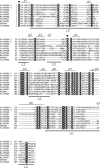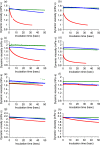A Lytic Polysaccharide Monooxygenase with Broad Xyloglucan Specificity from the Brown-Rot Fungus Gloeophyllum trabeum and Its Action on Cellulose-Xyloglucan Complexes
- PMID: 27590806
- PMCID: PMC5086550
- DOI: 10.1128/AEM.01768-16
A Lytic Polysaccharide Monooxygenase with Broad Xyloglucan Specificity from the Brown-Rot Fungus Gloeophyllum trabeum and Its Action on Cellulose-Xyloglucan Complexes
Abstract
Fungi secrete a set of glycoside hydrolases and lytic polysaccharide monooxygenases (LPMOs) to degrade plant polysaccharides. Brown-rot fungi, such as Gloeophyllum trabeum, tend to have few LPMOs, and information on these enzymes is scarce. The genome of G. trabeum encodes four auxiliary activity 9 (AA9) LPMOs (GtLPMO9s), whose coding sequences were amplified from cDNA. Due to alternative splicing, two variants of GtLPMO9A seem to be produced, a single-domain variant, GtLPMO9A-1, and a longer variant, GtLPMO9A-2, which contains a C-terminal domain comprising approximately 55 residues without a predicted function. We have overexpressed the phylogenetically distinct GtLPMO9A-2 in Pichia pastoris and investigated its properties. Standard analyses using high-performance anion-exchange chromatography-pulsed amperometric detection (HPAEC-PAD) and mass spectrometry (MS) showed that GtLPMO9A-2 is active on cellulose, carboxymethyl cellulose, and xyloglucan. Importantly, compared to other known xyloglucan-active LPMOs, GtLPMO9A-2 has broad specificity, cleaving at any position along the β-glucan backbone of xyloglucan, regardless of substitutions. Using dynamic viscosity measurements to compare the hemicellulolytic action of GtLPMO9A-2 to that of a well-characterized hemicellulolytic LPMO, NcLPMO9C from Neurospora crassa revealed that GtLPMO9A-2 is more efficient in depolymerizing xyloglucan. These measurements also revealed minor activity on glucomannan that could not be detected by the analysis of soluble products by HPAEC-PAD and MS and that was lower than the activity of NcLPMO9C. Experiments with copolymeric substrates showed an inhibitory effect of hemicellulose coating on cellulolytic LPMO activity and did not reveal additional activities of GtLPMO9A-2. These results provide insight into the LPMO potential of G. trabeum and provide a novel sensitive method, a measurement of dynamic viscosity, for monitoring LPMO activity.
Importance: Currently, there are only a few methods available to analyze end products of lytic polysaccharide monooxygenase (LPMO) activity, the most common ones being liquid chromatography and mass spectrometry. Here, we present an alternative and sensitive method based on measurement of dynamic viscosity for real-time continuous monitoring of LPMO activity in the presence of water-soluble hemicelluloses, such as xyloglucan. We have used both these novel and existing analytical methods to characterize a xyloglucan-active LPMO from a brown-rot fungus. This enzyme, GtLPMO9A-2, differs from previously characterized LPMOs in having broad substrate specificity, enabling almost random cleavage of the xyloglucan backbone. GtLPMO9A-2 acts preferentially on free xyloglucan, suggesting a preference for xyloglucan chains that tether cellulose fibers together. The xyloglucan-degrading potential of GtLPMO9A-2 suggests a role in decreasing wood strength at the initial stage of brown rot through degradation of the primary cell wall.
Copyright © 2016 Kojima et al.
Figures







Similar articles
-
pH-Dependent Relationship between Catalytic Activity and Hydrogen Peroxide Production Shown via Characterization of a Lytic Polysaccharide Monooxygenase from Gloeophyllum trabeum.Appl Environ Microbiol. 2019 Feb 20;85(5):e02612-18. doi: 10.1128/AEM.02612-18. Print 2019 Mar 1. Appl Environ Microbiol. 2019. PMID: 30578267 Free PMC article.
-
Discovery of LPMO activity on hemicelluloses shows the importance of oxidative processes in plant cell wall degradation.Proc Natl Acad Sci U S A. 2014 Apr 29;111(17):6287-92. doi: 10.1073/pnas.1323629111. Epub 2014 Apr 14. Proc Natl Acad Sci U S A. 2014. PMID: 24733907 Free PMC article.
-
Quantifying Oxidation of Cellulose-Associated Glucuronoxylan by Two Lytic Polysaccharide Monooxygenases from Neurospora crassa.Appl Environ Microbiol. 2021 Nov 24;87(24):e0165221. doi: 10.1128/AEM.01652-21. Epub 2021 Oct 6. Appl Environ Microbiol. 2021. PMID: 34613755 Free PMC article.
-
Functional characterization of cellulose-degrading AA9 lytic polysaccharide monooxygenases and their potential exploitation.Appl Microbiol Biotechnol. 2020 Apr;104(8):3229-3243. doi: 10.1007/s00253-020-10467-5. Epub 2020 Feb 19. Appl Microbiol Biotechnol. 2020. PMID: 32076777 Review.
-
Advances in lytic polysaccharide monooxygenases with the cellulose-degrading auxiliary activity family 9 to facilitate cellulose degradation for biorefinery.Int J Biol Macromol. 2022 Oct 31;219:68-83. doi: 10.1016/j.ijbiomac.2022.07.240. Epub 2022 Aug 2. Int J Biol Macromol. 2022. PMID: 35931294 Review.
Cited by
-
Transcriptome analysis of the brown rot fungus Gloeophyllum trabeum during lignocellulose degradation.PLoS One. 2020 Dec 14;15(12):e0243984. doi: 10.1371/journal.pone.0243984. eCollection 2020. PLoS One. 2020. PMID: 33315957 Free PMC article.
-
Enzymatic degradation of xyloglucans by Aspergillus species: a comparative view of this genus.Appl Microbiol Biotechnol. 2021 Apr;105(7):2701-2711. doi: 10.1007/s00253-021-11236-8. Epub 2021 Mar 24. Appl Microbiol Biotechnol. 2021. PMID: 33760931 Review.
-
Enzymatic debranching is a key determinant of the xylan-degrading activity of family AA9 lytic polysaccharide monooxygenases.Biotechnol Biofuels Bioprod. 2023 Jan 5;16(1):2. doi: 10.1186/s13068-022-02255-2. Biotechnol Biofuels Bioprod. 2023. PMID: 36604763 Free PMC article.
-
pH-Dependent Relationship between Catalytic Activity and Hydrogen Peroxide Production Shown via Characterization of a Lytic Polysaccharide Monooxygenase from Gloeophyllum trabeum.Appl Environ Microbiol. 2019 Feb 20;85(5):e02612-18. doi: 10.1128/AEM.02612-18. Print 2019 Mar 1. Appl Environ Microbiol. 2019. PMID: 30578267 Free PMC article.
-
Bioinformatic Analysis of Lytic Polysaccharide Monooxygenases Reveals the Pan-Families Occurrence of Intrinsically Disordered C-Terminal Extensions.Biomolecules. 2021 Nov 4;11(11):1632. doi: 10.3390/biom11111632. Biomolecules. 2021. PMID: 34827630 Free PMC article.
References
MeSH terms
Substances
LinkOut - more resources
Full Text Sources
Other Literature Sources

